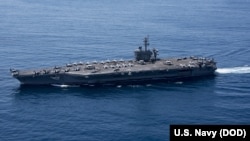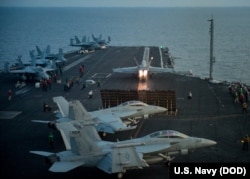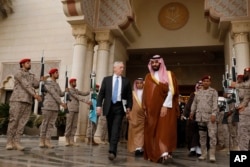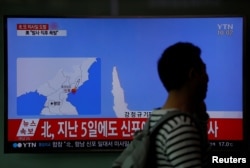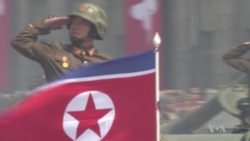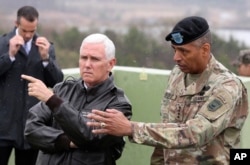The U.S. sought to assure allies Wednesday that the USS Carl Vinson naval strike group is indeed headed to the northern Pacific as a deterrent to North Korea's nuclear weapons program. But this came after days of misleading statements that the aircraft carrier and other ships had already been headed there.
"We're sending an armada, very powerful," President Donald Trump declared April 11, three days after the strike group left Singapore.
Admiral Harry Harris, commander of the U.S. Pacific Command, had announced April 9 he was ordering the strike group to sail north after leaving Singapore and that it would not be making previously planned port visits in Australia.
However the strike group instead stayed in the western Pacific and conducted an abbreviated set of exercises with Australian forces. By last Saturday, the Vinson was sailing through the Sunda Strait, which separates the Indonesian islands of Java and Sumatra, thousands of kilometers from the Korean peninsula.
On Wednesday, U.S. officials attempted to clarify the conflicting statements about the strike group's whereabouts.
White House spokesman Sean Spicer noted Trump's comment "that we have an armada going towards the peninsula. That's a fact, it's happened. It is happening rather."
“What part is misleading? I’m trying to figure that out…I’m not the one who commented on timing,” said Spicer.
Defense Secretary Jim Mattis, on a visit to Saudi Arabia, told reporters, "The Vinson, as I’ve said on the record, was operating up and down the western Pacific. And we’re doing exactly what we said. And that is, we’re shifting her, instead of continuing one direction as she pulled out of Singapore she’s going to continue part of our cruise down in that region but she was on her way up to Korea."
Mattis then said, "She will be on her way. And I’ll determine when she gets there and where she actually operates. But the Vinson is going to be part of our ensuring that we stand by our allies in the northwest Pacific."
The mixed messaging is being viewed by some as undermining the United States' credible threat of military force against North Korea.
‘Duped by Trump: U.S. Taunted Over Carl Vinson Aircraft Carrier Tale,’ was the headline in the conservative business daily Wall Street Journal, which noted “ridicule in some corners of Asia and wariness in others.”
The headline in China’s Global Times read ‘Tricked Badly,’ while the Korea Times in Seoul bluntly declared ‘US lied about carrier strike group.’
Carrier to spend extra month off Korean Peninsula
After the initial U.S. Pacific Command announcement on April 9 stated that the Carl Vinson Strike Group was headed north toward the Western Pacific Ocean, a spokesman for the command told VOA and other news organizations this was motivated by North Korea’s “reckless, irresponsible and destabilizing program of missile tests and pursuit of a nuclear weapons capability.”
This raised concerns that Trump might launch a unilateral military strike to prevent or retaliate against a possible North Korean nuclear test on April 15, the birth anniversary of the nation’s founder Kim Il Sung, often marked by a provocative weapons test.
North Korea did not conduct a nuclear test that weekend but held a massive military parade and attempted a missile test at or near its key submarine base at Sinpo.
The Vinson and its strike force is believed to still be in the Indian Ocean, engaged in training exercises with Australia and is now expected to arrive in waters off the Korean peninsula around April 25, when North Korea marks an important holiday: Military Foundation Day.
It is now confirmed that the aircraft carrier’s crew will spend at least an extra month at sea.
“Our deployment has been extended 30 days to provide a persistent presence in the waters off the Korean peninsula,” the group’s commander, Rear Adm. James Kilby, wrote Wednesday on the group’s Facebook page.
Watch: Naval Strike Force Heads to Korean Peninsula Days After US Claims It Had
Ambiguous messaging damages credibility
The perceived communications mix-up discredits some of the tough rhetoric coming from the Trump administration.
"If you threaten them and your threat is not credible, it's only going to undermine whatever your policy toward them is," said North Korea expert Joel Wit at the 38 North monitoring group, run by Johns Hopkins University's School of Advanced International Studies.
Analyst Daniel Pinkston with Troy University in Seoul, said this policy of increased military pressure is not only weakened by mixed messages over deploying a naval strike force, but also by widespread opposition among important allies such as Japan and South Korea.
“They are not going to support some military adventurism to take a gamble with the execution of some preventive military operation against North Korea. It’s just not going to happen,” Pinkston told VOA.
U.S. Vice President Mike Pence did not mention the delay in sending the Vinson group Wednesday when he addressed American military forces aboard the USS Ronald Reagan, a Nimitz class aircraft carrier undergoing maintenance in Yokosuka, Japan.
Pence instead repeated stern warnings to Pyongyang that he made earlier in Seoul and Tokyo, not to test America’s resolve. He again referenced Trump’s decisions to launch missile strikes in Syria and Afghanistan, and said the United States is fully prepared to use military force if needed.
“Those who challenge our resolve or our readiness should know, we will defeat any attack and meet any challenge and use conventional or nuclear weapons with an overwhelming and effective American response,” the vice president said.
The USS Carl Vinson strike group includes the flagship aircraft carrier, along with its air wing, destroyers USS Wayne E. Meyer and USS Michael Murphy and the cruiser USS Lake Champlain.
(VOA Pentagon Correspondent Carla Babb in Riyadh, VOA Northeast Asia Correspondent Brian Padden and Youmi Kim in Seoul, Ken Bredemeier contributed to this report.)




